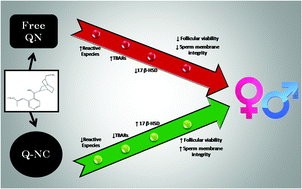Effect of quinine-loaded polysorbate-coated nanocapsules on male and female reproductive systems of rats
Abstract
Quinine is an antimalarial drug; however, its use is limited by its narrow therapeutic index and elevated side effects. The nanosystems are promising delivery vehicles of antimalarial drugs, enhancing their therapeutic potential. This study aimed to compare the toxicity of quinine and quinine loaded nanocapsules (Q-NC) on the reproductive system of male and female rats. The animals received quinine or Q-NC orally at the same dose of 25 mg kg−1 for 7 days (real period of quinine therapy in humans). 24 hours after the last administration, the rats were euthanized and the ovarian and testicular tissues were removed for histological and biochemical analyses. The groups treated with quinine presented ovarian and testicular damage, evidenced by the increase of reactive species and malondialdehyde levels, the decrease of 17β-hydroxysteroid dehydrogenase activity and alterations on total antioxidant capacity. The females presented a decrease of follicular viability and the males presented a decrease of spermatozoa membrane integrity, as well as moderated histological alterations on testis after the exposure to quinine. After the treatment with Q-NC, the males presented decreased reactive species levels and total antioxidant capacity at control levels, as well as spermatozoa with 100% of membrane integrity. The females treated with Q-NC presented reactive species levels, total antioxidant capacity, 17β-hydroxysteroid dehydrogenase activity and follicular viability at control levels, and decreased malondialdehyde levels when compared to quinine, but not at control levels. This study demonstrated that loading polymeric nanocapsules with quinine decreased the deleterious effects induced by quinine on ovaries and partially on testicles.


 Please wait while we load your content...
Please wait while we load your content...